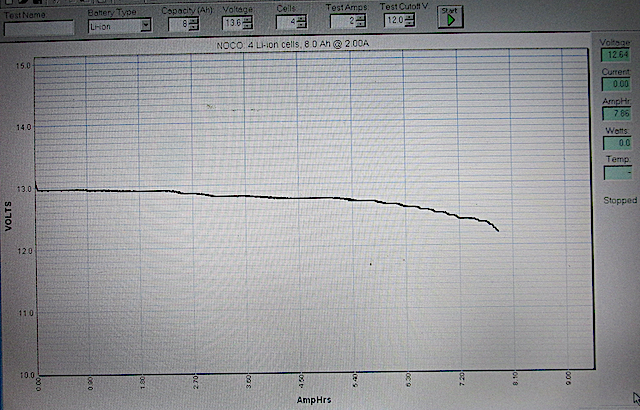Hey Matt - "Mitsi" (that's what I named our first i-MiEV), welcome to the forum.
Good question, and one I've been mulling over as I've built my own LiFePO4 battery but haven't installed it yet as I'm still tinkering with the BMS.
I looked over the specs of the NOCO NLP30 LiFePO4 battery and here are my thoughts -
1) Cell balancing
Their description sounds impressive and it looks as though they have continuous active balancing. I wouldn't worry about it as it's in their best interest to keep those cells balanced no matter what you do.
2) Overvoltage protection
Presumably by opening the connection. Edit: this voltage is probably slightly above 14.6v, which is high already. You'll never see it as the i-MiEV dc-dc is 14.4v (or a bit less in hot weather). Besides, they say it recovers when an external load is applied.
3) Undervoltage protection
Again, presumably by opening the connection. I doubt if you'll ever get there, certainly not when driving unless there's a fault in the i-MiEV. It might happen if you leave the car parked without a float
charger for a few weeks. They say it recovers if you put it on a
charger.
4) Charging Voltage
They say 14.6v but that's already rather high (edit: actually at the absolute upper voltage limit) for LiFePO4, so the i-MiEV's 14.4v (or a bit lower) will be just fine, as long as the NOCO cells remain balanced. I normally charge my LiFePO4 cells to 3.4v (x4= 13.6vdc) edit: as that's close to the charging knee above which there's not much energy.
5) Battery Capacity
They say 8Ah (and even say 32Ah lead-acid equivalent) so you'll be just fine as long as you don't let the car sit unused for more than a couple of weeks, and just put a float
charger on it if you do.
6) Overcurrent Protection
They say it will recover when the external load is removed, but they don't say what happens if the maximum 24A charging current is exceeded; however, they also spec a continuous discharge current of 80A, so whatever protection they have will still allow that much current to go into the battery.
7) Maximum Charging Current
This 24A spec is the only one I might be concerned about, as the i-MiEV dc-dc has the ability to feed a discharged NOCO with a higher current. Since the i-MiEV supplies a constant regulated voltage I suspect that the battery current will be self-limiting as soon as its voltage has reached that 14.4v voltage limit. In any case, be sure to have a fully charged NOCO when you first install it, which should minimize any initial high current. Since you're in a continuous-use scenario when you're driving, I don't see a problem as the dc-dc will simply keep the voltage constant and the battery will just sit there floating. The problem occurs if you've not driven the car and allowed the battery to be discharged by the i-MiEV's vampire loads. They don't say what happens if you exceed 24A charging current - I'd be inclined to call up NOCO and ask them, but be sure to tell them that the voltage is constrained to 14.4vdc max.
8) Terminals
I see that the polarity orientation matches the i-MiEV OEM battery; however, in order not to butcher the connection, you might consider a terminal adapter, something like this -
Edit 1 Dec.2021: the shorter post with M6x1.0 screw that comes with the post fits perfectly!
https://www.amazon.com/XS-Power-580-Adaptor-Thread/dp/B004XH67B2
Edit: or maybe this taller post (check the NOCO dimensions for best fit):
https://www.amazon.com/XS-Power-586-Adaptor-Thread/dp/B004XH69MY
9) Low Temperature
LiFePO4 don't like being charged at low temperatures, and they spec -10°C as their lower limit.
Edit: This IS a major problem in your part of the world - see subsequent discussions, especially http://myimiev.com/forum/viewtopic.php?f=23&t=3067&start=60#p44032 Hopefully you have a garage that doesn't get that low. In NOCO's User Guide they say it recovers when it gets back to in-spec temperatures, but doesn't say if it cuts out by going open circuit. They simply say the BMS doesn't allow charging below -10°C. You might ask NOCO that question as well.
My Conclusion (debate welcomed) -
All that having been said, I'd go for it and install the NOCO but do charge up the battery to 14.4v before installing it, and
please do let us know how it works out.
Yet another edit:
Mitsi said:
... Yet in their manual they specify using a Lithium Ion battery charger. The charge voltage is specified at 14.6V and max charging current of 24A...
You do realize that NOCO wants to sell you their
charger? Any modern regulated
charger will work for you. If it doesn't have a lithium setting, then just set it to
Gel (or maybe even AGM -
read the charger specs) to avoid exceeding the 14.6v upper limit. Their battery 24A maximum charge current limit is pretty high and most portable
chargers are lower than that, so no problem.



































